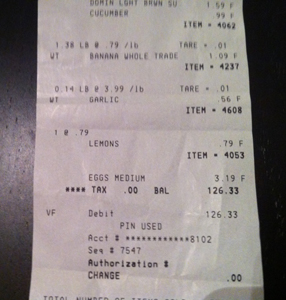Have you ever pictured yourself doing a happy dance in the grocery store because you could afford oranges? No? Me neither, but that’s what happened during my 30-day challenge to feed my family of three at or near the poverty level. There were also moments of frustration and a few tears shed. Here’s how it all started …
I was roaming around a section of the USDA website where they keep track of over 8,000 families and what they spend every month for groceries. This helps them set four different budget levels: Thrifty (near the poverty level), Low, Medium, and Liberal. Amounts are broken down by gender and age; kids and the elderly account for less money than 20-something guys, for instance. 
If you think this is a futile exercise and a waste of taxpayer money, you’d be wrong. If you’re going through a divorce, it’s likely that the courts will assess child support at the “Low” level, no matter your income. The food that our servicemen and women are served is budgeted at the Liberal level. So this monthly assessment by the government has a bigger effect than you might realize.
When I looked at the numbers, I realized my family was living at the “Low” level, but that wasn’t taking into account how often we eat out (two to three meals per week between lunches and dinner). The amount we spend does reflect us eating a lot of organic foods. Plus, we can sometimes be too wasteful; I cringe some weeks at what we throw away. It’s not just a waste of money, but a waste of resources for the planet.
Could our family live at the Thrifty level? What would it take? And what if I tried doing this while only shopping at Whole Foods, aka “Whole Paycheck”? And then what if I also threw a dinner party for eight as the very last meal?
I contacted Whole Foods and suggested a bet. If I could feed my family of three for 30 days exclusively from items purchased at Whole Foods for $491.10 they would reimburse me for my food. If I didn’t make it, they’d owe me nothing. The budget worked out to $16.31 cents per day total for all three of us. In case you’re wondering, here’s what we bought for the month.
Whole Foods said yes, my family was gung ho, and we were off on January 1st, shopping for over 90 minutes, trying to figure out what we could afford.
The first two weeks were the hardest. We started with a nearly empty pantry, just a bit of vanilla, salt, pepper, and other dry seasonings and that was it. We had to buy all our staples, which took a huge chunk from the budget. During the second week, we were hoping to be able to afford more veggies than the previous week, but we were thwarted by prices. We did buy quite a bit of canned and frozen veggies, but very little fresh. I cried on the way home, frustrated at what I could provide for my family and wondering how people who lived at this level all the time handled it.
 I’d like to point out here that the USDA Thrifty Budget is about 30% higher than the federal SNAP program. There’s no way you can eat healthfully on food stamps; it’s just not possible.
I’d like to point out here that the USDA Thrifty Budget is about 30% higher than the federal SNAP program. There’s no way you can eat healthfully on food stamps; it’s just not possible.
Then we hit the “Madness Sale!” Whole Foods runs a Madness Sale about once a month with some pretty amazing, stock-up-now specials. The big score for us was chicken breast, normally $4.99/pound, for only $2.99/pound! We bought 12 pounds, enough to last us through to the end of the challenge. That freed $24 in the budget that was originally pegged for proteins and we were able to use that for fruits and veggies.
Our next grocery trip I was dancing, literally dancing, as I picked up some oranges and happily placed them in the cart. Our dinner party, something we had fretted over all month, became easy as we had plenty of money for homemade bread, a chicken veggie stir fry, and two types of brownies for dessert. We even had enough to buy three bottles of wine for our guests; the cabernet was surprisingly good for only $3!
What We Learned
Whole Foods has a Value Tour you can take (just call ahead) where they show you how to save money shopping at the store. It’s really invaluable and you can ask a lot of questions, which they’ll happily answer.
Frozen veggies are a great option, especially if you live in the Northeast like I do. Fresh veggies were at a premium and didn’t always look like they were worth the price, but the frozen varieties were healthy, tasted fresh, and worked great in sauces, stir fries, or even just as a side dish.
The more labor you do, the less it costs. It took me all of 10 minutes prep time to put together two loaves of bread a week, and it only cost $1.25 for both loaves. I saved a ton of money, the bread was fresh, lasted all week, and tasted yummy. There were lots of other instances where it was just so much better to make it from scratch.
Check prices in different areas of the store. Whole Foods offers nuts in bulk bins, plastic containers, and sealed plastic bags. Turns out the ones in the plastic bags are cheapest by volume, but we wouldn’t have known that if we hadn’t checked! This can be true for meats and produce too.
 Not all specials are advertised. Whole Foods hypes between 100 and 150 specials per week but they might have as many as 2,000 items on sale. (Yes it’s that high!) So be open-minded and always check pricing to see what is the best deal. You might be surprised and it can vary week-to-week.
Not all specials are advertised. Whole Foods hypes between 100 and 150 specials per week but they might have as many as 2,000 items on sale. (Yes it’s that high!) So be open-minded and always check pricing to see what is the best deal. You might be surprised and it can vary week-to-week.
During the month, we ate every meal from my kitchen, including my son’s lunch for school. We also live in Boston, an expensive urban area with a limited supply of fresh produce during the winter; prices do vary considerably depending on where you live.
Do you think you could do it? Here’s a roundup of our entire 30-Day Challenge adventures including weekly posts and frugal recipes. I’d love to see other people try this for themselves and see their results.
It’s been a week or so since our challenge ended and, after a day of eating a ton of junk, we went right back to home cooking. I have a lot more confidence that I can make just about anything taste as good as a local restaurant, and I’m more adventurous now with my cooking.
Lisa Johnson is a food blogger at True Food Movement. A Pilates studio owner and fitness blogger by day, she is a mean scratch cook by night and can frequently be found hanging on Twitter @LisaJohnson.
Also Read:
Learn How to Coupon to Save on Healthy Groceries
